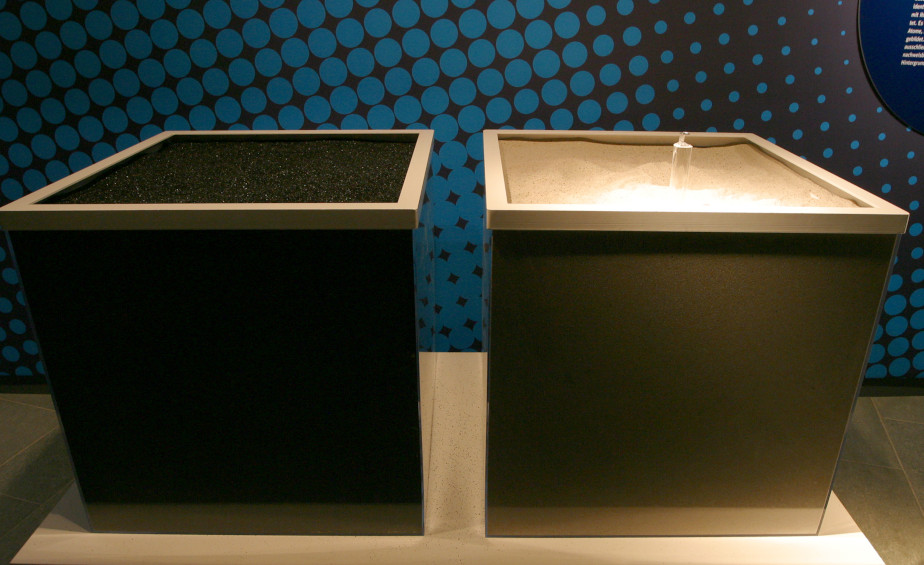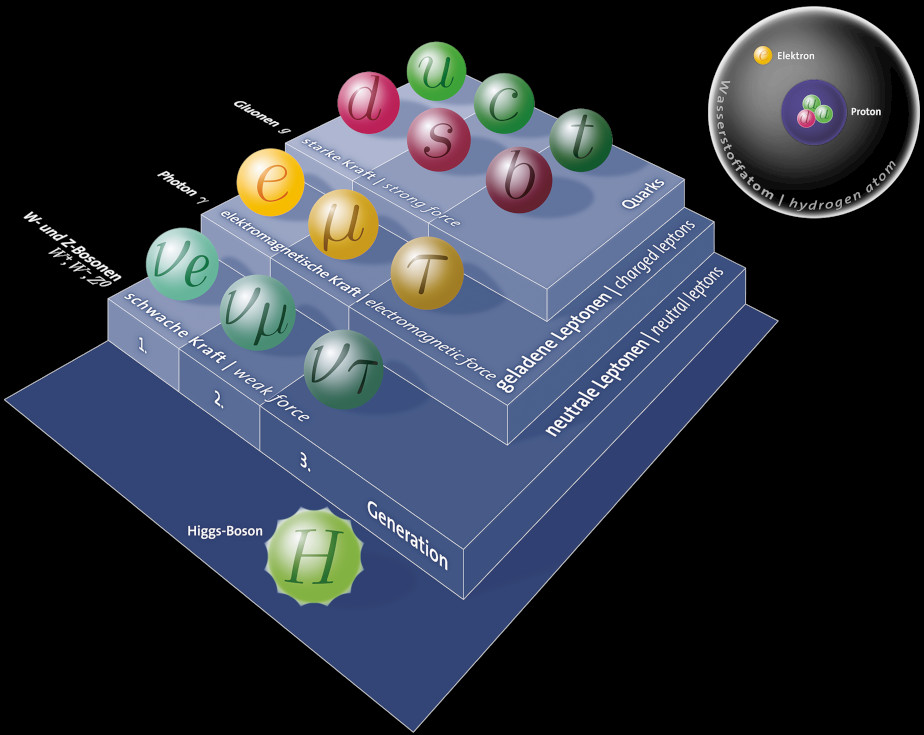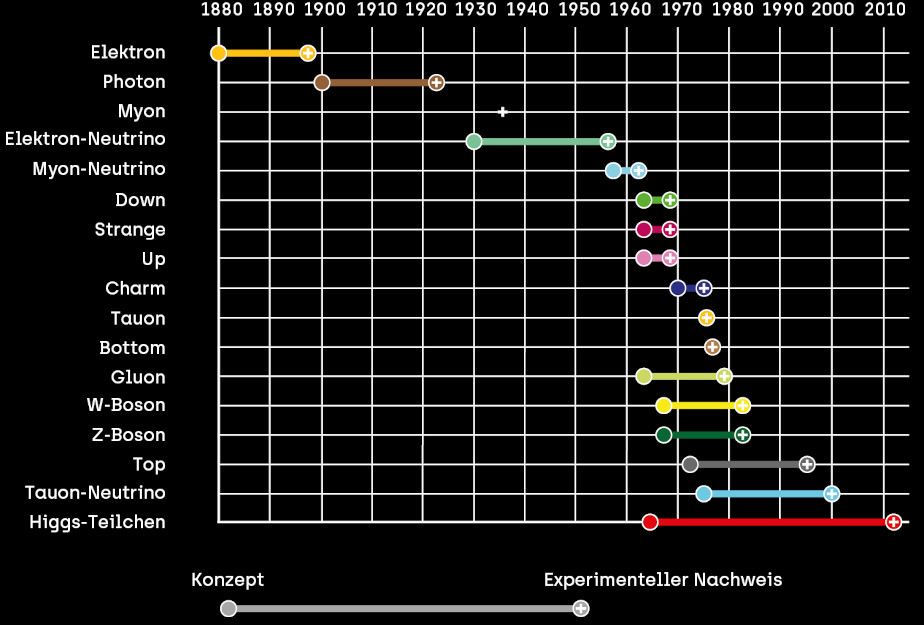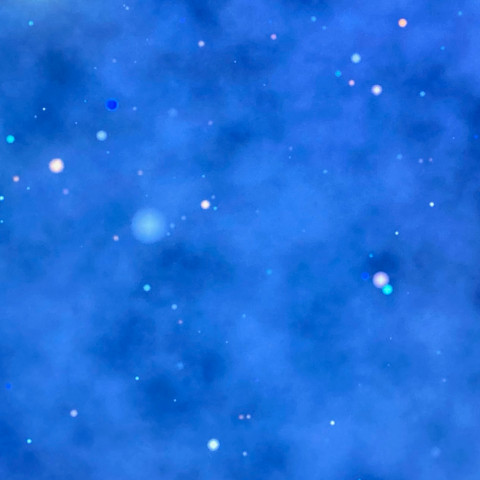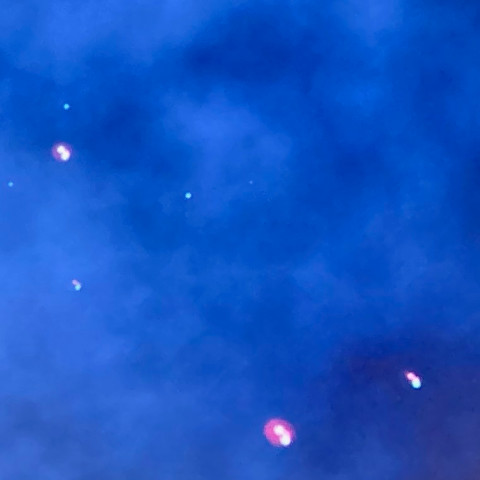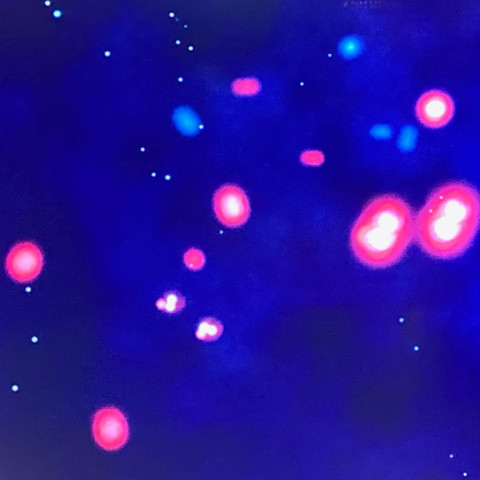Big Bang
The Age of Elementary Particles
Once nothing more than a philosophical hypothesis, today the Big Bang is a scientific fact. While we cannot be absolutely certain about precisely how the universe was born, we do know that it was once extremely dense and hot.
Astronomical observations of distant galaxies show that the universe is expanding: objects in the universe move away from each other faster when they are further apart. Conversely, this means that the universe used to be smaller and came into being a long time ago. According to our calculations this was 13.8 billion years ago.
Scientists assume that at that time space and time came into being spontaneously and expanded explosively, and that the universe gradually filled up with the various particles of all kinds.
But what was before the Big Bang?
Many people ask themselves this. The honest answer is: we don't know; this is where philosophy and religion have to look for answers.
The Big Bang - basic explanation
Where do we come from? We're not talking about your hometown, but the things you are made of. You are made of skin, hair, bones, muscles, water, and so on. What are all these things made of? Chemical molecules! And what are those made of? Of atoms! And those? Out of particles. And those? Particles cannot be divided any more, but they must have originated somewhere.
Scientists say that the whole universe was created in the Big Bang almost 14 billion years ago. The whole universe was smaller than a pinhead at that time. It suddenly exploded and space, time and matter all came into existence with the Big Bang.
Even today, the universe continues to expand. You can think of the galaxies as dots on a balloon that you blow up: each galaxy a dot, the balloon the universe. The bigger you inflate the balloon, the more the dots move away from each other. Now you may wonder if there are other living beings in this huge universe: there might be! So far, we haven't discovered any, but we're still looking. But one thing we know for sure: if there are aliens, they consist of the same particles as we do.
(Note: video is in German)
The age of elementary particles
After the Big Bang, when the universe was in a state of extremely high density and temperature, a unified "primordial force" prevailed. There were no elementary particles yet, only tiny oscillating loops called "strings".
Shortly after the Big Bang, there was a period of inflation in which the entire universe inflated by a factor of 1026 (i.e. by a hundred septillion – a 1 with 26 zeros!) within 10-32 s (i.e. within a hundred millionths of a septillionth of a second – let's just say: in an extremely short time). Only after this "inflation" did the cosmos expand at the speed we can calculate and measure today.
It was so hot that one billionth of a second (10-9 s) after the Big Bang, all known particles were present in their elementary form. After a millionth of a second, the universe had expanded and cooled enough for quarks to combine to form protons and neutrons. After three minutes, protons and neutrons combined to form atomic nuclei. Only after about 380,000 years had the universe cooled down to about 2,700 degrees. Now the first stable hydrogen atoms could form. The universe became transparent and light particles, photons, could escape. Photons make things visible to our telescopes – so it is only from this point on that we can observe the universe.
Particle physics is the key to understanding the very first moments of the universe. With a particle accelerator, we can recreate the state of matter that prevailed shortly after the Big Bang. In this way, particle physics helps us to better understand the birth of our universe.
"Particle Zoo" exhibition
As part of the exhibition "Particle Zoo" a video series (in German) was created, answering the question "What are particles really?"
Check out the website of this exhibition to find particle profiles for all of the elementary particles like quarks, photons, electrons etc. Or you can try out the particle-o-mat and find out which of the elementary particles is most like you.
The "Particle Zoo" exhibition is a joint project of the DESY research centre and Universum® Bremen. It took place in Bremen from 27 September 2013 until 30 June 2014.
Matter and antimatter
Elementary particles, such as quarks, gluons, and electrons, are the smallest known building blocks of the universe.
Each elementary particle has a number of fundamental characteristics that remain unchanged: mass (internal energy), spin (intrinsic angular momentum) and aspects such as its electrical charge. For every particle there is an anti-particle with the same mass and the same spin but the opposite electrical charge. Like atoms comprising protons, neutrons, and electrons, their anti-particles form anti-atoms – also known as antimatter.
During the Big Bang, matter and antimatter were produced in (almost) the same quantity. As the universe began to cool, a process of destruction was set in motion. Particles and anti-particles collided and were transformed into photons. At the end of this process there was a tiny amount of matter left over. This was the basis for all galaxies, stars, and planets.
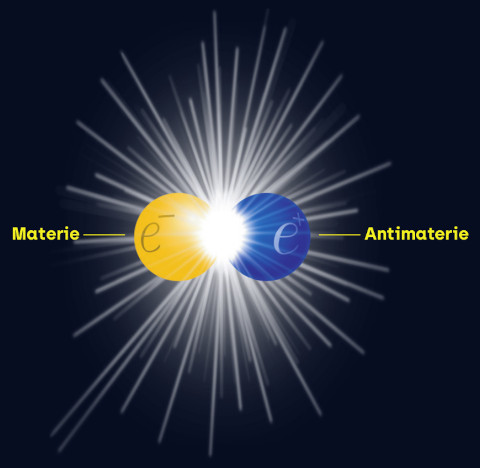
The quest for the Higgs boson
The universe is one ten billionth of a second old and has a temperature of one quadrillion degrees.
Something very special could have happened here: the birth of matter as we know it. This could be where the elementary particles got their mass. Matter as we know it today is made up of three elementary particles: up quarks, down quarks, and electrons. All three have mass. But where does this mass come from? In search of an explanation, in the 1960s particle physicists developed a revolutionary theory: the Brout-Englert-Higgs mechanism. According to this theory the universe is filled with a kind of ‘syrup’, known as the Higgs field. This field gives structure to the vacuum of the universe and slows down the particles passing through it. This is what gives the particles their mass. The stronger a particle’s reaction to the Higgs field, the more mass it receives.
Peter Higgs also recognised that this field must itself be connected to particles. In 2012, almost fifty years later, researchers at CERN managed to provide proof of this ‘Higgs boson’ using the particle accelerators. This was an important milestone in our understanding of the universe.
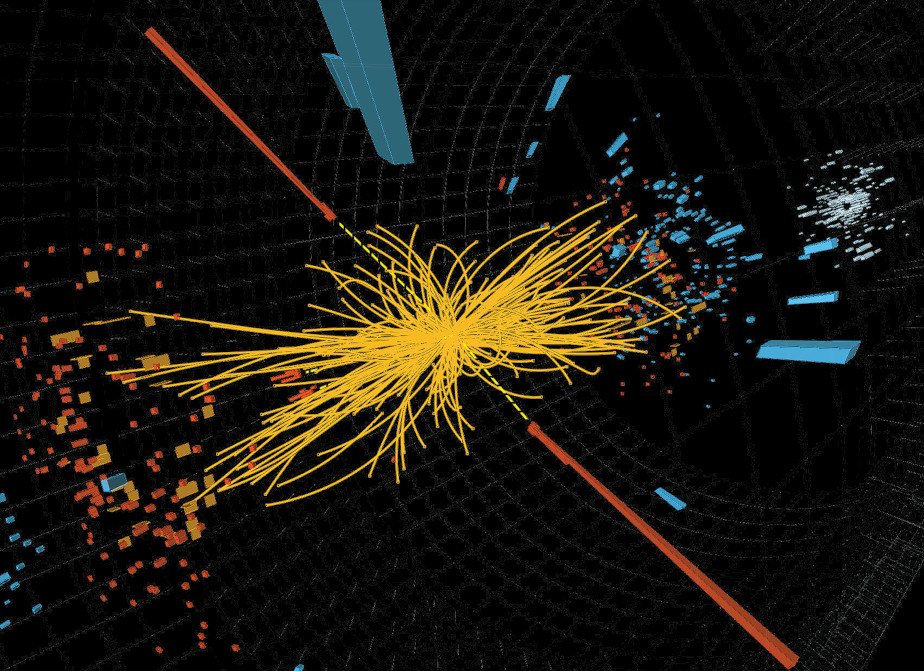
The creation of protons and neutrons
The universe is a millionth of a second old and has a temperature of 1,000 billion degrees.
In the first millionth of a second after the Big Bang the universe had a density of 100 kg/cm3. It was filled with sub-atomic particles – quarks and gluons – which can today no longer be observed in a ‘free’ state. However, they can be generated in large particle accelerators by creating high-energy collisions. By doing so, researchers can learn more about a physical state which last existed immediately after the Big Bang.
As the universe continued to cool, the quarks and gluons condensed – like droplets of water on a cold surface – to form protons and neutrons, the building blocks of atomic nuclei. By the way, the gluon was discovered in 1979 at the PETRA accelerator at the DESY research centre in Hamburg.
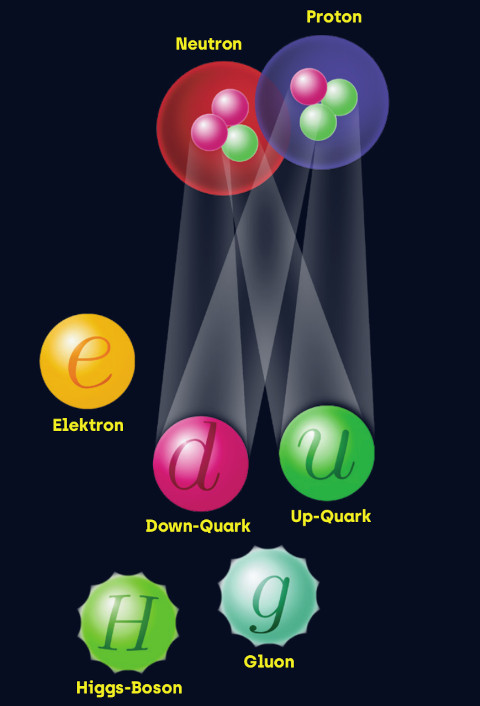
Discovering Gluons
Sau Lan Wu and Georg Zobernik, from the University of Wisconsin, had written an extremely efficient program to analyse the collisions in which quarks were formed, and had also calculated that it ought to be possible to create gluons in PETRA by means of bremsstrahlung at collision energies above around 22 GeV. Finally, in June 1979, a few days before a conference in Bergen (Norway), the TASSO scientists identified the first event consisting of three distinctive jets in their data, as Event 13177 of Run 447. Freshly analysed, so to speak, Bjørn Wiik took it along to the “Neutrino 79” in Bergen on 18 June and placed it on the overhead projector as the last transparency of his presentation “First Results from PETRA”. It was to become the transparency with the greatest repercussions: the gluon had seen the light of (the scientific) day.
Read more about how the gluon was discovered in Hamburg here in this article by DESY.
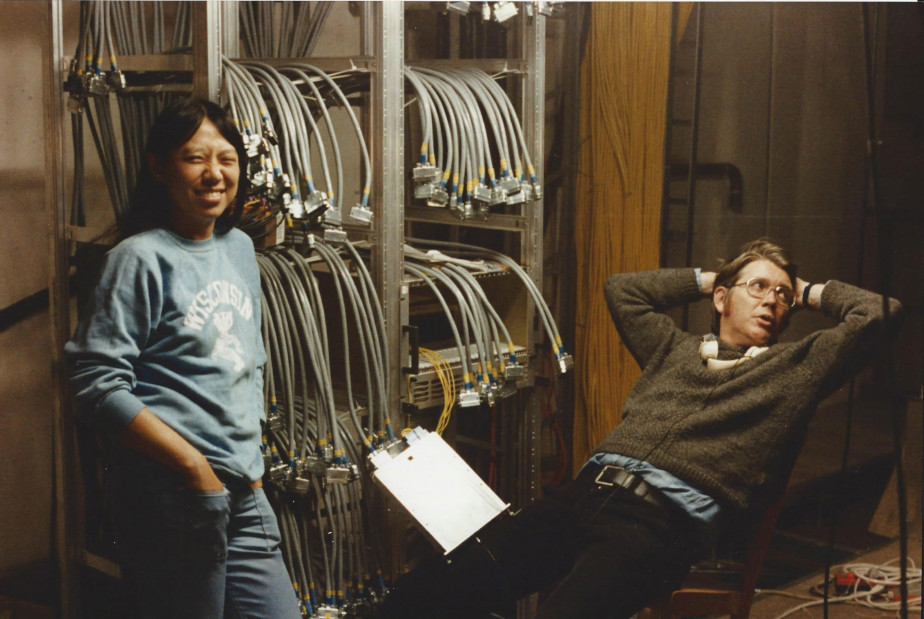
The birth of the first chemical elements
The universe is a few seconds old and has a temperature of a few billion degrees. It had already cooled down from the immeasurably high temperature it had at the very beginning to a few billion degrees. These "cooler" conditions meant that protons and neutrons could form the first stable atomic nuclei in the following three minutes. These were nuclei of the lightest elements: hydrogen, helium and traces of lithium. The atomic nuclei of the heavier elements only formed later through nuclear fusion inside stars.
The abundance of the light elements can be calculated, and the data agree with astronomical measurements – an important step towards accepting the Big Bang hypothesis.
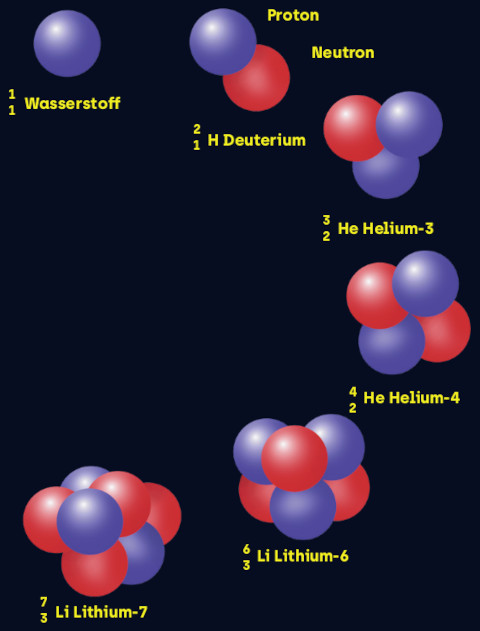
The universe becomes transparent
The universe is 380,000 years old and has a temperature of 2,700 degrees.
Shortly before, the universe had been a huge fireball comprised mainly of charged atomic nuclei and free electrons embedded into myriads of light particles known as photons. Such was the temperature that it was impossible for neutral atoms to form. The photons whizzing around were absorbed and unable to penetrate the universe.
It was not until the temperature had dropped to 2,700 degrees that all atomic nuclei and electrons bonded together to form atoms. Instead of being absorbed, the photons could now pass through this ‘neutral’ matter. 380,000 years after the Big Bang, the universe became ‘transparent’. The cosmic background radiation that we can still observe today is made up of these first photons which penetrated the universe.

Construction kit for the universe
Decades of research have led to the development of a kind of construction kit for the universe. It is called the standard model of particle physics and encompasses our entire understanding of the fundamental particles and their interactions.
Elementary particles - basic explanation
The universe is huge and very complicated. There is not only the earth or the moon or our solar system, but countless solar systems in countless galaxies. There are stars that explode or collapse and black holes that swallow everything. And there are probably even things that we don't even know about yet because we can't see them.
To understand how our universe works, we first need to know what it is made of. We also need to know how these things work together. Like if you want to play a game, you have to understand the rules first.
Unfortunately, we can't see the smallest components of matter with the naked eye or with microscopes. That's why we need particle accelerators. Scientists use them to let particles crash onto other particles in order to find out which particles exist and, above all, how these particles relate to each other because those particles follow strict rules. They found out that there are matter particles - that's what we and everything we know are made of - and messenger particles that implement the rules of the game.
In the particle world there are exactly four rules: the forces. There is the strong force that acts between tiny particles called quarks, the weak force that acts in the sun, the electromagnetic force that you know from everything that needs electricity and makes light, and gravity that keeps us on the ground and also acts between particles. By the way, the particle that transmits gravity has not been discovered yet. Maybe you'll go into science and be the one to find it?
(Note: video is in German)
Symmetries
Symmetries form the "principle of order" for describing the entire universe from the extremely small to the extremely large.
We know many symmetries from everyday life, for example the axial symmetry of a butterfly's wings or mirror images. Symmetries are also used for the journey to understand the world of the extremely small, such as gauge symmetry, a strict mathematical concept that determines the nature of forces.
If you look closely, however, the two wings of the butterfly are not completely symmetrical. Physicists call this a broken symmetry. It is the same in the description of the universe. At low temperatures, this gauge symmetry is spontaneously broken and mass terms can be assigned to the particles. This is called the "Brout-Englert-Higgs mechanism".
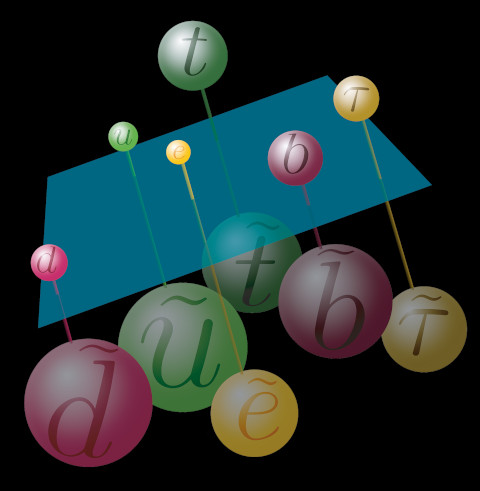
Is the world supersymmetrical?
Symmetries play a central role in physics, as they carry the basic principles of nature. Physicists are in search of the greatest possible symmetry, "supersymmetry." According to the theory of supersymmetry, every known particle has a supersymmetric partner particle: every electron a "selectron" and every photon a "photino." Every particle has its own mirror image, so to speak. The mirror particle of the photon is a candidate for the as yet undiscovered dark matter. So far, supersymmetry is only a theory. However, experiments in the LHC particle accelerator at CERN are searching for real supersymmetric partner particles.
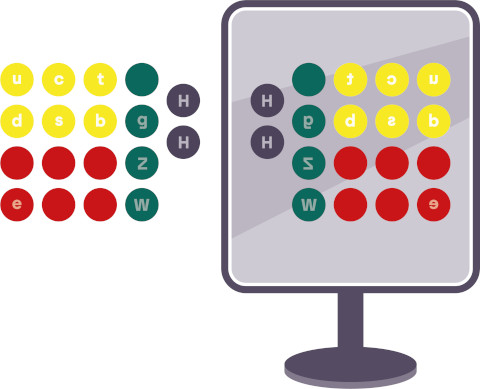
Journey back in time to the Big Bang
Embark on a journey through the age of the elementary particles. Take a journey back in time to the Big Bang. Learn more about the early universe. Which particles and forces existed then? How were atomic nuclei created? How did dark matter form?Strong couples
In today’s universe, quarks never occur on their own. They are always found either as a pair, as in mesons (quark and antiquark), or a triple combination as in protons and neutrons. It takes a huge amount of energy to separate quarks from each other, similar to the energy released shortly after the Big Bang. Try to separate the ‘strong couples’. When a quark-antiquark couple is split up, new quarks are created.Jana Schumacher
Jigsaw (2022)
In Jana Schumacher's drawings and installations, abstract structures are condensed into ornaments of existence. The artist spans an arc from the microcosm to the macrocosm, which leads into the depths of outer space. Her spatial ensemble, Jigsaw, symbolizes the quest of science, which also applies to art and humanity in general, to solve the great riddles of the universe: mysteries that particle physics is seeking to unravel through the exploration of dark matter. Countless black puzzle pieces are piled up into a mound on a surreal-looking conference table, which is modeled after Stanley Kubrick's satirical sci-fi classic, Dr. Strangelove (1964). Assembling the puzzle poses a near unsurmountable challenge that can only be mastered collectively, as the round table suggests. The potential overall picture that could emerge from the individual pieces of the game is just as elusive as dark matter itself: an enigmatic substance, which still continues to retain secrets. As in other works as well, Schumacher here addresses the confrontation with the unknown, which propels artists and scientists alike.
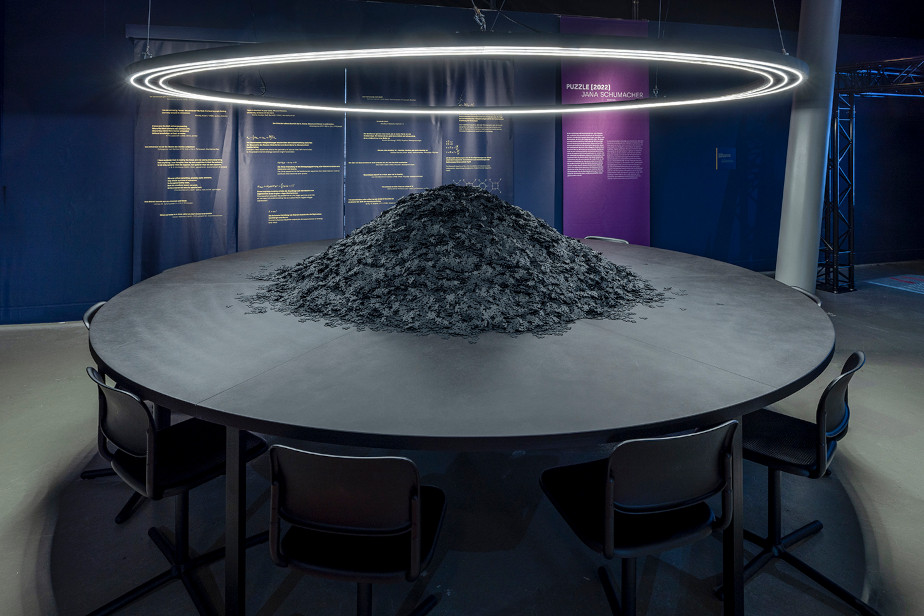
A grain of sand makes the difference
Elementary particles have so-called antiparticles. They annihilate each other when they collide. At the big bang, the same number of particles and antiparticles were created. But why do we exist, if actually all created matter and antimatter should have destroyed themselves completely? Scientists assume that there were particle decays in the early universe, in which a little more matter was created. In our model the grains of sand correspond to the matter and the antimatter - and it is owed to the one matter grain of sand more that there is us.